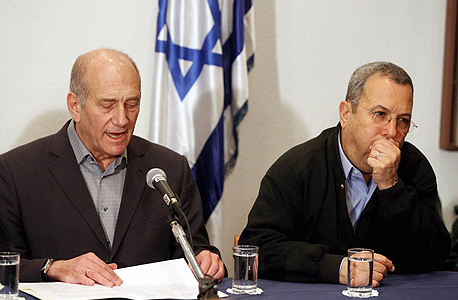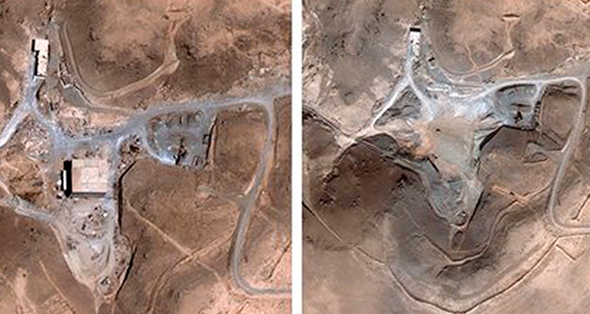Israel Confirms 2007 Attack on Syrian Nuclear Reactor
Between 12:40 a.m. and 12:53 a.m. on September 6, 2007, eight Israeli Air Force aircraft dropped 24 tons of ammunition on a nuclear reactor in northeastern Syria
For daily updates, subscribe to our newsletter by clicking here.
Between 12:40 a.m. and 12:53 a.m. on September 6, these aircraft dropped 24 tons of ammunition on Al-Kibar, which according to Israeli intelligence was a nuclear reactor built by Syrian President Bashar Assad with North Korean support. The reactor was destroyed, and with it, the Syrian nuclear program was eliminated.
In the decade that has passed since then, Israel persistently refused to take official responsibility for the operation, until the Israeli Military Censor decided this week to clear it for publication.
The international press and American officials who were never subjected to Israeli censorship were more vocal about the attack and Israel’s role in it. In April 2008, U.S. intelligence officials briefed Congress on their part in the Israeli attack on the reactor, and several sources in George W. Bush’s administration—including the president himself—addressed the affair in different ways in books and interviews.
The Israeli media, restricted from publishing any new information on the attack, had to result to citing “foreign reports,” which included detailed investigations by publications like The New Yorker magazine, Newsweek, the British Daily Telegraph, and German weekly Der Spiegel.
The reports were divisive. One report referred to the attack as “Operation Orchard,” and another called it “Operation Arizona;” one report alleged that the Mossad’s preliminary intelligence activity was carried out in Austria, and another said it took place in London; Few agreed on the number of planes that participated in the attack.
Despite the media attention, the Israeli government, headed by Prime Minister Ehud Olmert, never confirmed the reports or took responsibility for the attack.It was critical for Israel to avoid a public announcement that it was responsible for the destruction of the reactor in Deir ez-Zor. A decade later this scenario may seem unrealistic, but at the time Israel was concerned about Syrian retaliation that would lead to a regional conflict and to all-out war.
The Israeli assessment was that Assad would prefer to cover up the incident, to avoid the repercussions of his failure to report the construction of the reactor to the International Atomic Energy Agency (IAEA), not to mention the humiliation of having his nuclear ambitions shattered in an Israeli strike. If Israel avoided boasting about the attack in public, it would allow Assad plausible deniability.
Syria never retaliated in more than ten years that passed, while Israel launched a number of additional strikes against Syrian targets. These include the assassination of Hezbollah’s Chief of Staff Imad Mughniyeh in Damascus in 2008, the 2015 assassination of his son, Jihad Mughniyeh, and, since the beginning of the civil war there, a number of attacks on Lebanon-bound arms convoys and depots, responses to the spillover of mortar shells, and strikes against the military presence of Iran and Hezbollah in the Golan Heights.
The destruction of the reactor by Israel turned out to have a dramatic impact on the region’s future. The changes Syria has been going through over the past six years raise alarming questions on what could have happened had Assad achieved nuclear abilities. Equally alarming is the possibility that the reactor could have fallen into the hands of one of the radical Islamic groups fighting the regime. Maj.-Gen. (res.) Amos Yadlin, who served as Military Intelligence chief at the time of the operation, said recently that the strike prevented “a Middle East no one would have wanted to live in.”
The Al-Kibar reactor was destroyed as a result of a series of intelligence, diplomatic, political and military moves over the course of many tense months in the years 2006 and 2007. They took place in the Syrian desert, in the Mossad offices in Israel, in the White House, in the Prime Minister’s Residence in Jerusalem and in the Air Force headquarters, and according to foreign reports, in hotels in European capitals as well. Now, these moves have been cleared for publication.
***
In the years leading up to the strike, the U.S. and Israel became concerned about Bashar Assad's nuclear ambitions. His father, former President Hafez Assad, had tried to buy nuclear research reactors from Argentina and Russia in the 1990s, but those attempts were thwarted by American pressure.Towards the end of 2006, Israel began receiving information about a possible resumption of nuclear-related activity in Syria. According to then-Military Intelligence chief Yadlin and senior Mossad officials at the time, that was also when initial reports about a suspicious, mysterious building being renovated in a desert in northeastern Syria started arriving.
The building in Deir ez-Zor was constructed around 2002, and the North Korean activity aimed at turning it into a nuclear reactor began in 2004. In 2006, Israel’s Mossad received images from inside the building which indicated it was a nuclear plutonium reactor. It was located far from any large community, less than 1 kilometer from the Euphrates River, mid-way between the Iranian and Turkish borders. The pictures showed North Korean workers, and to the Israeli intelligence officials the facilities appeared identical to the unique Yongbyon nuclear reactor, which had been built by North Korea decades before.
In early March 2007, it was reported, Syria's atomic energy agency director Ibrahim Othman participated in an IAEA meeting in Vienna, Austria. According to a New Yorker report, on one of the days of the conference, Mr. Othman left his apartment living his personal computer behind. According to the Yorker, Mossad spies infiltrated the apartment, copied the material found on Mr. Othman laptop, installed a software providing them with remote access to the computer, and took off. Israel has yet to confirm the operation.
Several days later, then-Mossad chief Meir Dagan presented the findings to Prime Minister Olmert. Mr. Olmert vaguely addressed that “piece of information” that had been placed on his desk at a later occasion: “From that moment, I knew nothing would be the same again. The meaning, on the existential level, was unprecedented.”
Olmert began running the Begin Doctrine in his mind—a basic assumption enunciated by former Prime Minister Menachem Begin when he decided to attack the Osirak nuclear reactor in Iraq in 1981, that Israel would not allow an enemy state interested in its destruction to attain nuclear abilities.
Mr. Olmert made a decision almost immediately: Israel would attack the facility as soon as possible, before the reactor becomes “hot” and its radiation pollutes the region and the Euphrates River. The operation was about to kick off.***
Those days, Olmert suffered a drop in popularity in the wake of the 2006 war with Lebanon. In an attempt to reach a diplomatic breakthrough, he held talks with Arab and Muslim leaders in the months that preceded the discovery of the reactor.According to The New Yorker, in February 2007 he met with then-Turkish Prime Minister Recep Tayyip Erdogan in Ankara and asked him to explore whether Assad would be willing to launch secret talks with Israel. But the Syrian president’s positive response arrived only two months later, after the findings about the reactor had already been presented to Olmert and the discussions on a strike had begun.
In April 2007, Israel informed the U.S. government of its intention to strike in Syria, hoping for American collaboration.
President Bush instructed his people to verify the credibility of Israel’s claims. The CIA appointed a special team to look into the matter, and the pictures were compared to satellite images of the Syrian facility and examined by the National Geospatial-Intelligence Agency and by nuclear experts. The CIA team determined that the Israeli intelligence was accurate.Nevertheless, the U.S. government was still undecided on whether and how to act.
One of the reasons the Americans were afraid of a military operation was their polite uncertainty regarding the IDF’s abilities, in light of the Second Lebanon War, but there were two other main reasons. The first had to do with the American public opinion, which was partly fed up with the military intervention in the Middle East, and the other had to do with two international initiatives led by Secretary of State Condoleezza Rice, and which might have been thwarted by an attack on the Syrian reactor: The world powers’ talks with North Korea about its nuclear project, and a Middle East peace conference that would be held in Annapolis.***
On June 19, 2007, Mr. Olmert met with President Bush to discuss the Syrian reactor. Mr. Olmert tried to convince the U.S. president to lead the attack on the reactor, arguing that such a move would kill two birds with one stone: It would allow the Americans to remind the world of Assad’s evil regime and would convey a message dissuading Iran from pursuing its own nuclear program. Mr. Olmert said that if the U.S. wouldn’t attack, Israel would go it alone.Two days earlier, the American president convened a meeting with his aides. According to the Washington Post, CIA Director Michael Hayden informed him that the reactor in the Syrian desert was indeed part of a nuclear program, but that since no other components of the program—like enrichment facilities—had been found, the Israeli findings should still be treated with “low confidence.”
While the administration conceded that the reactor could go hot in the coming months, President Bush decided he lacked the public and political justification for an operation in Syria.
In his memoir, Mr. Bush wrote that he had told Mr. Olmert he couldn’t launch an attack on a sovereign state unless his intelligence organizations made it clear to him that there was a nuclear weapon involved.
On July 13, 2007, President Bush called the Israeli prime minister and told him that if the U.S. wanted to bomb the reactor, the administration would have to explain to Congress that the intelligence had come from Israel. Mr. Olmert rejected that option. Elliott Abrams, deputy to National Security Advisor Stephen Hadley, later revealed in an interview to Amnon Levy on Channel 10 that Olmert had replied: “If you don’t bomb, we will. That’s all I’m going to tell you. You don’t want to know how or when.”
***
Ahead of the operation to destroy the reactor, the IDF began preparing for a war with Syria. In the summer of 2007, the ground forces conducted exercises and carrying out preparations only in battalions and brigades, so as not to raise suspicions in Damascus. Only few senior officers were aware of the real reason for the preparations.In early September, however, the cabinet realized it had to act quickly. According to a senior intelligence official, an American journalist had submitted a question to the spokesperson of the Israeli Embassy in Washington: was Israel aware of a nuclear reactor for military purposes being built by Syria on its territory?
Even if the cabinet had considered postponing the operation, that option was no longer relevant. Such a media report would reveal to Assad that he had been exposed and prompt him to act. On September 5, the Security Cabinet deliberated for the last time and voted to grant Mr. Olmert, Defense Minister Ehud Barak, and Foreign Minister Tzipi Livni sole power to approve the military approach and the timing of the strike, which was launched later that day.
Shortly after the planes returned to Israel, Mr. Olmert contacted President Bush. “I just want to report to you that something that existed doesn’t exist anymore. It was done with complete success,” Mr. Olmert said.
Satellite images that arrived at the IDF headquarters the following morning revealed that the reactor was destroyed and split in half, in a way that would make it impossible to put it to use again.
The next day, the official Syrian news agency reported that Israeli planes had infiltrated the country’s airspace but were driven away, after dropping ammunition in a desert area without causing any injuries or damage.
Three weeks later, Assad gave an interview to the BBC and said that Israeli warplanes had attacked an unused military building and that Damascus reserved “the right to retaliate.” Syrian Ambassador the United Nations Bashar Ja’afari insisted that nothing had been bombed in Syria and that Israeli planes “were encountered by our air defense fire” and were forced to drop their ammunition and fuel tanks.
Israel helped Assad ensure his plausible deniability and sought to refrain from making any public statements on the matter.
Related stories
The denial game on both sides lasted many more months. Assad rejected repeated IAEA requests to visit the bombed site, before giving a limited group of international observers access to the place in June 2008. They found traces of radioactive material there, but Syria claimed those were traces of the Israeli strike. Another year passed before an IAEA investigation officially concluded that the site bore features resembling a nuclear reactor.
In 2013, the Al-Jazeera network published what it purported to be documentation from the site of the facility after it was conquered from the Assad regime by the Free Syrian Army. According to the report, they found no traces pointing to the existence of a nuclear facility, but did find long-range Scud missiles there.



No Comments Add Comment